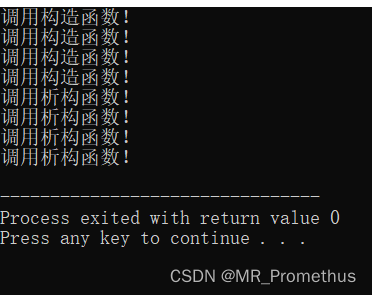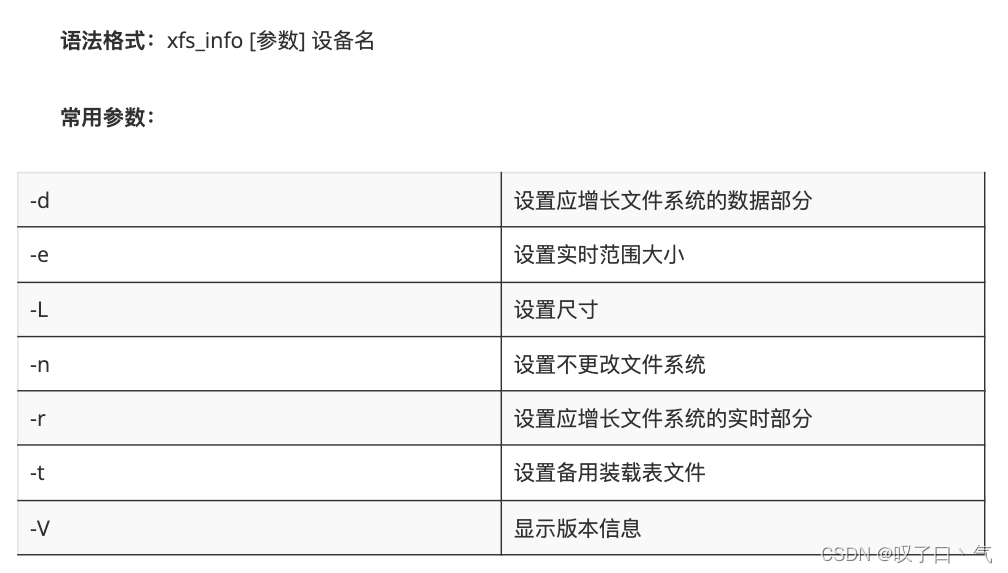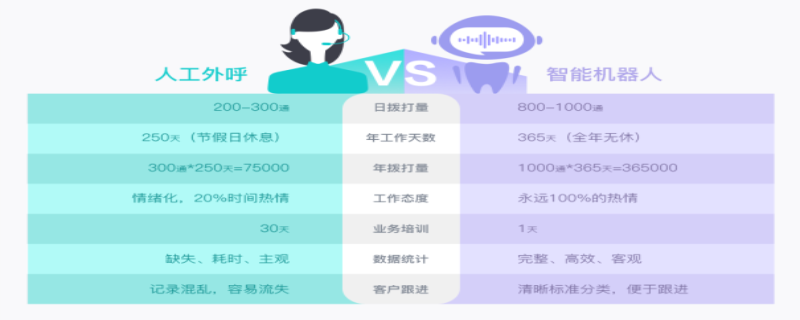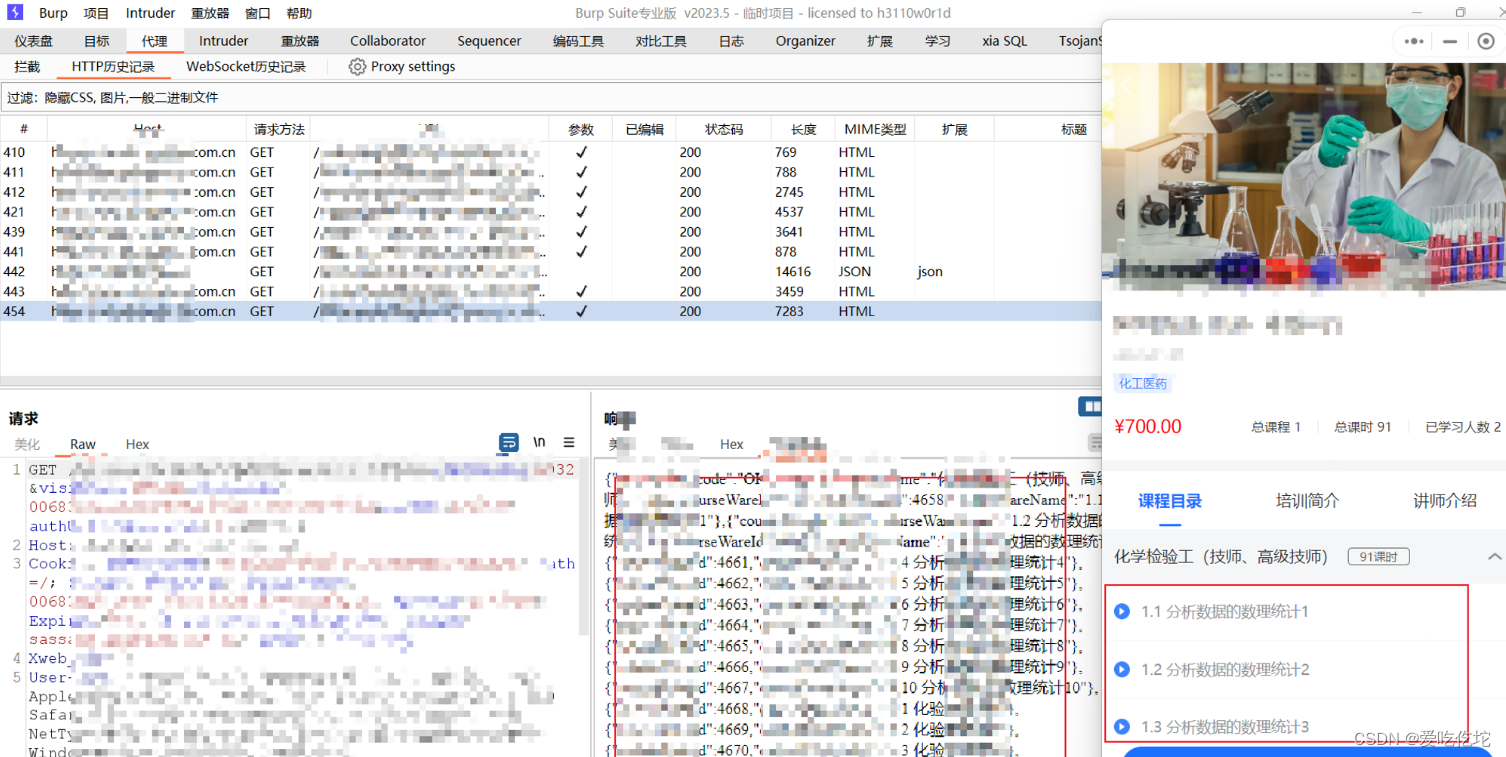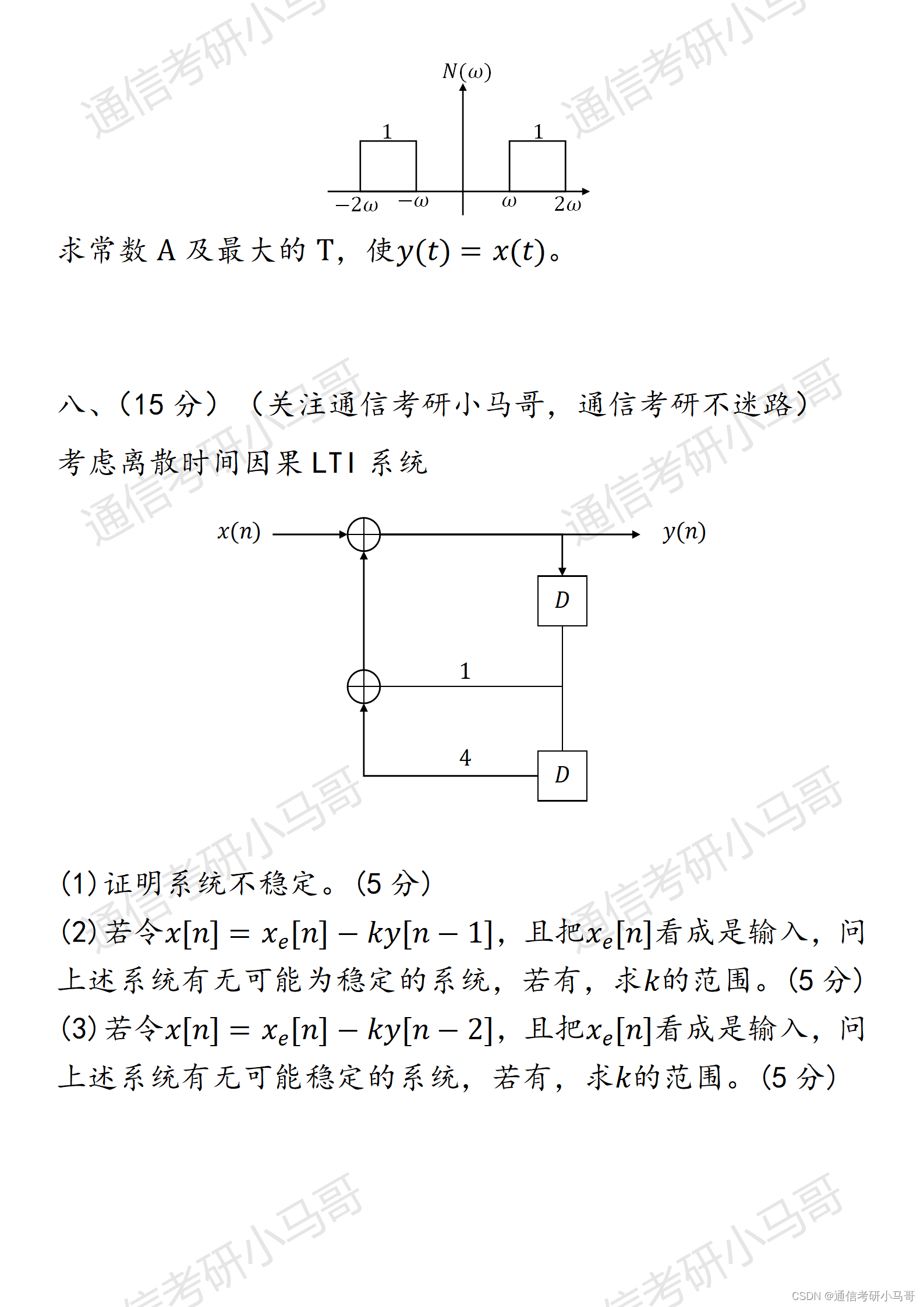目录
一、unordered系列关联式容器
(一)unordered_set
(二)unordered_map
练习:961. 在长度2N的数组中找出重复N次的元素
二、哈希的底层结构
(一)哈希概念
(二)哈希冲突
三、哈希冲突解决(闭散列)
(一)线性探测
1. 仿函数(将key值转整型)
2. 插入
3. 查找和删除
4. 完整代码
(二)二次探测
四、哈希冲突解决(开散列)
(一)插入
(二)删除
(三)桶的数量、最大长度、平均长度
(四)完整代码
一、unordered系列关联式容器
- 在C++98中,STL提供了底层为红黑树结构的一系列关联式容器,在查询时效率可达到$log_2N$,即最差情况下需要比较红黑树的高度次,当树中的节点非常多时,查询效率也不理想。最好的查询是,进行很少的比较次数就能够将元素找到,因此在C++11中,STL又提供了4个unordered系列的关联式容器,这四个容器与红黑树结构的关联式容器使用方式基本类似,只是其底层结构不同
- 树状关联式容器(比如C++中的
std::map和std::set)通常使用比较函数(仿函数)来确定元素的顺序,这样可以进行元素的大小比较。而哈希容器(比如C++中的std::unordered_map和std::unordered_set)需要将键转换为整数值,通常使用哈希函数(也是通过仿函数实现)来计算键的哈希值,然后将哈希值用于确定存储位置或进行快速查找
(一)unordered_set

#include <iostream>
#include <unordered_set>
using namespace std;
int main()
{
unordered_set<int>s;
s.insert(1);
s.insert(3);
s.insert(5);
s.insert(1);
s.insert(2);
unordered_set<int>::iterator it = s.begin();
while (it != s.end())
{
cout << *it << " ";
++it;
}
//1 3 5 2
return 0;
}
(二)unordered_map

- unordered_map是存储<key, value>键值对的关联式容器,其允许通过keys快速的索引到与其对应的value。
- 在unordered_map中,键值通常用于惟一地标识元素,而映射值是一个对象,其内容与此键关联。键和映射值的类型可能不同。
- 在内部,unordered_map没有对<kye, value>按照任何特定的顺序排序,为了能在常数范围内找到key所对应的value,unordered_map将相同哈希值的键值对放在相同的桶中
#include <iostream>
#include <unordered_map>
using namespace std;
int main()
{
unordered_map<string,string>dict;
dict["sort"] = "排序";
dict["string"] = "字符串";
unordered_map<string, string>::iterator it = dict.begin();
while (it != dict.end())
{
cout << it->first << " "<<it->second<<endl;
++it;
}
//sort 排序
//string 字符串
return 0;
}
练习:961. 在长度2N的数组中找出重复N次的元素
力扣(LeetCode)官网 - 全球极客挚爱的技术成长平台

class Solution {
public:
int repeatedNTimes(vector<int>& nums) {
int n = nums.size();
unordered_map<int, int> m;
for(int i=0;i<nums.size();i++)
{
m[nums[i]]++;
}
unordered_map<int, int>::iterator it = m.begin();
while(it!=m.end())
{
if(it->second == n/2)
{
return it->first;
}
++it;
}
return 0;
}
};二、哈希的底层结构
(一)哈希概念
理想的搜索方法:可以不经过任何比较,一次直接从表中得到要搜索的元素。
如果构造一种存储结构,通过某种函数(hashFunc)使元素的存储位置与它的关键码之间能够建立一一映射的关系,那么在查找时通过该函数可以很快找到该元素。
当向该结构中:
- 插入元素:根据待插入元素的关键码,以此函数计算出该元素的存储位置并按此位置进行存放
- 搜索元素:对元素的关键码进行同样的计算,把求得的函数值当做元素的存储位置,在结构中按此位置取元素比较,若关键码相等,则搜索成功
该方式即为哈希(散列)方法,哈希方法中使用的转换函数称为哈希(散列)函数,构造出来的结构称
为哈希表(Hash Table)(或者称散列表)

(二)哈希冲突
- 不同关键字通过相同哈希哈数计算出相同的哈希地址,该种现象称为哈希冲突或哈希碰撞。
- 把具有不同关键码而具有相同哈希地址的数据元素称为“同义词”
三、哈希冲突解决(闭散列)
- 闭散列:也叫开放定址法,当发生哈希冲突时,如果哈希表未被装满,说明在哈希表中必然还有空位置,那么可以把key存放到冲突位置中的“下一个” 空位置中去。
如何寻找下一个空位置?
(一)线性探测
hashi+i(i>=0) ,i可以是0,1,2,3
- 从发生冲突的位置开始,依次向后探测,直到寻找到下一个空位置为止
hashi++;
hashi = hashi % _tables.size();- 如果发生越界,继续从0开始探测
1. 仿函数(将key值转整型)
模板特化中使用了一个简单的哈希算法,遍历字符串中的每个字符,将哈希值乘以一个常数(31),然后加上当前字符的 ASCII 值。这样的操作可以在一定程度上减少哈希冲突。这个特化的哈希函数适用于处理字符串类型的关键字
//伪函数,关键字转换成无符号整型
template<class K>
struct HashFunc
{
size_t operator()(const K& key)
{
return (size_t)key;
}
};
template<>//模板特化
struct HashFunc<string>//特化的哈希函数模板,专门用于处理 string 类型的关键字
{
size_t hash = 0;
size_t operator()(const string& key)
{
for (auto e : key)
{
hash *= 31;
hash += e;
}
return hash;
}
};2. 插入
bool Insert(const pair<K, V>& kv)
{
//负载因为0.7就扩容
if (_n * 10 / _tables.size() == 7)
{
size_t newsize = _tables.size() * 2;
HashTable<K, V> newHash;
newHash._tables.resize(newsize);
//遍历旧表依次将数据插入
for (int i = 0; i < _tables.size(); i++)
{
if (_tables[i]._s == EXIST)
{
newHash.Insert(_tables[i]._kv);
}
}
_tables.swap(newHash._tables);//交换旧哈希表和新哈希表
}
Hash hf;
// 线性探测
size_t hashi = hf(kv.first) % _tables.size();
while (_tables[hashi]._s == EXIST)
{
hashi++;
hashi = hashi % _tables.size();
}
_tables[hashi]._kv = kv;
_tables[hashi]._s = EXIST;
++_n;
return true;
}3. 查找和删除
HashData<K, V>* Find(const K& key)
{
Hash hf;
size_t hashi = hf(key) % _tables.size();
while (_tables[hashi]._s != EMPTY)//容易出错
{
if (_tables[hashi]._s == EXIST && _tables[hashi]._kv.first == key)
{
return &_tables[hashi];
}
hashi++;
hashi = hashi % _tables.size();//越界的时候,继续从头开始探测(查找)
}
return nullptr;
}
bool Erase(const K& key)//删除
{
HashData<K, V>* ret = Find(key);
if (ret != nullptr)
{
ret->_s = DELETE;//修改状态为删除
--_n;//数据个数减少
return true;
}
else
{
return false;
}
}4. 完整代码
- HashTable.h
#pragma once
#include<vector>
#include<string>
namespace Imitate_HashTbale
{
enum Status//哈希表每个空间状态标记
{
EMPTY,//空
EXIST,//存在数据
DELETE//已被删除
};
template<class K, class V>
struct HashData
{
pair<K, V> _kv;
Status _s;//标记哈希表每个位置的状态
};
//伪函数,关键字转换成无符号整型
template<class K>
struct HashFunc
{
size_t operator()(const K& key)
{
return (size_t)key;
}
};
template<>//模板特化
struct HashFunc<string>//特化的哈希函数模板,专门用于处理 string 类型的关键字
{
size_t hash = 0;
size_t operator()(const string& key)
{
for (auto e : key)
{
hash *= 31;
hash += e;
}
return hash;
}
};
template<class K, class V, class Hash = HashFunc<K>>
class HashTable
{
public:
HashTable()//构造函数
{
_tables.resize(10);
}
bool Insert(const pair<K, V>& kv)
{
//负载因为0.7就扩容
if (_n * 10 / _tables.size() == 7)
{
size_t newsize = _tables.size() * 2;
HashTable<K, V> newHash;
newHash._tables.resize(newsize);
//遍历旧表依次将数据插入
for (int i = 0; i < _tables.size(); i++)
{
if (_tables[i]._s == EXIST)
{
newHash.Insert(_tables[i]._kv);
}
}
_tables.swap(newHash._tables);//交换旧哈希表和新哈希表
}
Hash hf;
// 线性探测
size_t hashi = hf(kv.first) % _tables.size();
while (_tables[hashi]._s == EXIST)
{
hashi++;
hashi = hashi % _tables.size();
}
_tables[hashi]._kv = kv;
_tables[hashi]._s = EXIST;
++_n;
return true;
}
HashData<K, V>* Find(const K& key)
{
Hash hf;
size_t hashi = hf(key) % _tables.size();
while (_tables[hashi]._s != EMPTY)//容易出错
{
if (_tables[hashi]._s == EXIST && _tables[hashi]._kv.first == key)
{
return &_tables[hashi];
}
hashi++;
hashi = hashi % _tables.size();//越界的时候,继续从头开始探测(查找)
}
return nullptr;
}
bool Erase(const K& key)//删除
{
HashData<K, V>* ret = Find(key);
if (ret != nullptr)
{
ret->_s = DELETE;//修改状态为删除
--_n;//数据个数减少
return true;
}
else
{
return false;
}
}
void print()
{
for (int i = 0; i < _tables.size(); i++)
{
if (_tables[i]._s == EXIST)
{
cout << "[" << i << "]" << "->" << _tables[i]._kv.first << ":" << _tables[i]._kv.second << endl;
}
}
cout << endl;
}
private:
vector<HashData<K, V>> _tables;
size_t _n;//存放关键字的个数
};
void test1()
{
HashTable<int, int> HT;
int data[] = { 1,3,6,2,7,9 ,5,67,8,19 };
for (auto ch : data)
{
HT.Insert(make_pair(ch, ch));
}
HT.print();
if (HT.Find(99))
{
cout << "99存在" << endl;
}
else
{
cout << "99不存在" << endl;
}
if (HT.Erase(8))
{
cout << "成功删除8" << endl;
}
else
{
cout << "删除失败" << endl;
}
}
void test2()
{
string arr[] = { "香蕉", "甜瓜","苹果", "西瓜", "苹果", "西瓜", "苹果", "苹果", "西瓜", "苹果", "香蕉", "苹果", "香蕉" };
HashTable<string, int> ht;
for (auto& e : arr)
{
HashData<string, int>* ret = ht.Find(e);
if (ret != nullptr)//已经存在了
{
ret->_kv.second++;
}
else
{
ht.Insert(make_pair(e, 1));
}
}
ht.print();
}
}- test.c
#include<iostream>
using namespace std;
#include"HashTable.h"
int main()
{
Imitate_HashTbale::test2();
return 0;
}
(二)二次探测
hashi+i^2(i>=0)
- 线性探测的缺陷是产生冲突的数据堆积在一块,这与其找下一个空位置有关系,因为找空位置的方式就是挨着往后逐个去找,因此二次探测为了避免该问题
四、哈希冲突解决(开散列)
- 开散列法又叫链地址法(开链法),首先对关键码集合用散列函数计算散列地址,具有相同地址的关键码归于同一子集合,每一个子集合称为一个桶,各个桶中的元素通过一个单链表链接起来,各链表的头结点存储在哈希表中。
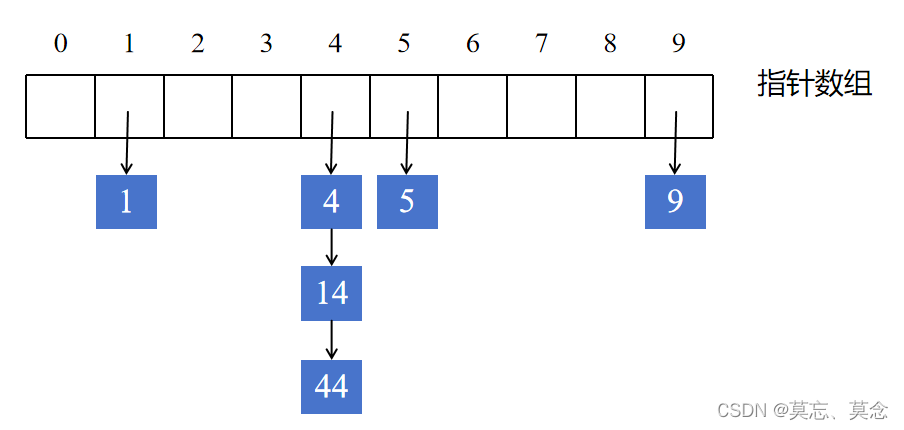
(一)插入
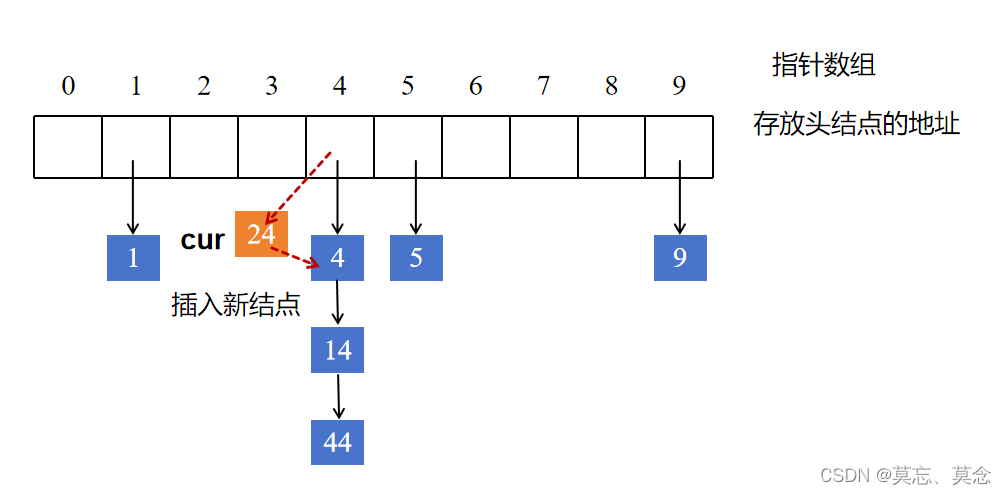
bool Insert(const pair<K, V>& kv)
{
if (Find(kv.first))
return false;
Hash hf;
// 负载因子最大到1
if (_n == _tables.size())
{
vector<Node*> newTables;
newTables.resize(_tables.size() * 2, nullptr);
//遍历旧表
for (size_t i = 0; i < _tables.size(); i++)
{
Node* cur = _tables[i];
while (cur)//循环将某一个桶中的所有结点进行头插
{
Node* next = cur->_next;
size_t hashi = hf(cur->_kv.first) % newTables.size();
//采用头插
cur->_next = newTables[hashi];
newTables[hashi] = cur;
cur = next;
}
_tables[i] = nullptr;//旧表置空
}
_tables.swap(newTables);
}
//插入结点
size_t hashi = hf(kv.first) % _tables.size();
Node* cur = new Node(kv);
//采用头插
cur->_next = _tables[hashi];
_tables[hashi] = cur;
++_n;
return true;
}(二)删除
bool Erase(const K& key)
{
Hash hf;
size_t hashi = hf(key) % _tables.size();
Node* cur = _tables[hashi];
Node* prev = nullptr;
while (cur)
{
if (cur->_kv.first == key)
{
if (cur == _tables[hashi])//删除头结点
{
_tables[hashi] = cur->_next;
}
else
{
prev->_next = cur->_next;
}
//释放结点
delete cur;
cur = nullptr;
--_n;
return true;
}
else
{
prev = cur;
cur = cur->_next;
}
}
return false;
}(三)桶的数量、最大长度、平均长度
void Some()
{
size_t bucketSize = 0;//使用桶的个数
size_t maxBucketLen = 0;//桶的最大长度
double averageBucketLen = 0;//桶的平均长度
size_t sum = 0;
for (size_t i = 0; i < _tables.size(); i++)
{
Node* cur = _tables[i];
if (cur != nullptr)
{
++bucketSize;
}
size_t bucketLen = 0;//记录一个桶的长度
while (cur)
{
++bucketLen;
cur = cur->_next;
}
sum += bucketLen;
//记录最大的桶的长度
if (bucketLen > maxBucketLen)
{
maxBucketLen = bucketLen;
}
}
averageBucketLen = double(sum) / bucketSize;//桶的平均长度
printf("all bucketSize:%d\n", _tables.size());
printf("bucketSize:%d\n", bucketSize);
printf("maxBucketLen:%d\n", maxBucketLen);
printf("averageBucketLen:%lf\n\n", averageBucketLen);
}(四)完整代码
#pragma once
#include<vector>
#include<string>
#include<cstdbool>
//namespace Imitate_hash_bucket
//{
template<class K, class V>
struct HashNode//结点定义
{
HashNode* _next;
pair<K, V>_kv;
HashNode(const pair<K, V>& kv)
:_kv(kv)
, _next(nullptr)
{
;
}
};
//伪函数,关键字转换成无符号整型
template<class K>
struct HashFunc
{
size_t operator()(const K& key)
{
return (size_t)key;
}
};
template<>//模板特化
struct HashFunc<string>//特化的哈希函数模板,专门用于处理 string 类型的关键字
{
size_t hash = 0;
size_t operator()(const string& key)
{
for (auto e : key)
{
hash *= 31;
hash += e;
}
return hash;
}
};
template<class K, class V, class Hash = HashFunc<K>>
class HashTable
{
typedef HashNode<K, V> Node;
public:
HashTable()
{
_tables.resize(10);
}
~HashTable()
{
for (size_t i = 0; i < _tables.size(); i++)
{
Node* cur = _tables[i];
while (cur)
{
Node* next = cur->_next;//cur的后驱结点
delete cur;
cur = next;
}
_tables[i] = nullptr;
}
}
bool Insert(const pair<K, V>& kv)
{
if (Find(kv.first))
return false;
Hash hf;
// 负载因子最大到1
if (_n == _tables.size())
{
vector<Node*> newTables;
newTables.resize(_tables.size() * 2, nullptr);
//遍历旧表
for (size_t i = 0; i < _tables.size(); i++)
{
Node* cur = _tables[i];
while (cur)//循环将某一个桶中的所有结点进行头插
{
Node* next = cur->_next;
size_t hashi = hf(cur->_kv.first) % newTables.size();
//采用头插
cur->_next = newTables[hashi];
newTables[hashi] = cur;
cur = next;
}
_tables[i] = nullptr;//旧表置空
}
_tables.swap(newTables);
}
//插入结点
size_t hashi = hf(kv.first) % _tables.size();
Node* cur = new Node(kv);
//采用头插
cur->_next = _tables[hashi];
_tables[hashi] = cur;
++_n;
return true;
}
Node* Find(const K& key)
{
Hash hf;
size_t hashi = hf(key) % _tables.size();
Node* cur = _tables[hashi];
while (cur)
{
if (cur->_kv.first == key)
{
return cur;
}
else
{
cur = cur->_next;
}
}
return nullptr;
}
bool Erase(const K& key)
{
Hash hf;
size_t hashi = hf(key) % _tables.size();
Node* cur = _tables[hashi];
Node* prev = nullptr;
while (cur)
{
if (cur->_kv.first == key)
{
if (cur == _tables[hashi])//删除头结点
{
_tables[hashi] = cur->_next;
}
else
{
prev->_next = cur->_next;
}
//释放结点
delete cur;
cur = nullptr;
--_n;
return true;
}
else
{
prev = cur;
cur = cur->_next;
}
}
return false;
}
void Some()
{
size_t bucketSize = 0;//使用桶的个数
size_t maxBucketLen = 0;//桶的最大长度
double averageBucketLen = 0;//桶的平均长度
size_t sum = 0;
for (size_t i = 0; i < _tables.size(); i++)
{
Node* cur = _tables[i];
if (cur != nullptr)
{
++bucketSize;
}
size_t bucketLen = 0;//记录一个桶的长度
while (cur)
{
++bucketLen;
cur = cur->_next;
}
sum += bucketLen;
//记录最大的桶的长度
if (bucketLen > maxBucketLen)
{
maxBucketLen = bucketLen;
}
}
averageBucketLen = double(sum) / bucketSize;//桶的平均长度
printf("all bucketSize:%d\n", _tables.size());
printf("bucketSize:%d\n", bucketSize);
printf("maxBucketLen:%d\n", maxBucketLen);
printf("averageBucketLen:%lf\n\n", averageBucketLen);
}
private:
vector<Node*>_tables;
size_t _n;
};
void test1()
{
HashTable<int, int>ht;
int data[] = { 1,4,2,7,8,12,6 };
for (auto e : data)
{
ht.Insert(make_pair(e, e));
}
if (ht.Find(12))
{
cout << "12找到了" << endl;
}
else
{
cout << "未找到" << endl;
}
//ht.Erase(4);
//ht.Erase(2);
}
void test2()
{
const int N = 100;
vector<int>v;
HashTable<int, int> ht;
srand(time(0));
for (size_t i = 0; i < N; i++)
{
v.push_back(rand() + i); // 重复值相对少
}
for (auto e : v)
{
ht.Insert(make_pair(e, e));
}
ht.Some();
}
void test3()
{
string arr[] = { "香蕉", "甜瓜","苹果", "西瓜", "苹果", "西瓜", "苹果", "苹果", "西瓜", "苹果", "香蕉", "苹果", "香蕉" };
HashTable<string, int> ht;
for (auto& e : arr)
{
HashNode<string, int>* ret = ht.Find(e);
if (ret)
{
ret->_kv.second++;
}
else
{
ht.Insert(make_pair(e, 1));
}
}
}
//}
#include<iostream>
using namespace std;
#include"HashTable.h"
int main()
{
//Imitate_hash_bucket::test3();
test3();
return 0;
}



